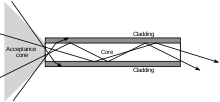- Waveguide (optics)
-
This page is about waveguides for transmission of optical signals or power. For other types of waveguide, see the disambiguation page Waveguide
An optical waveguide is a physical structure that guides electromagnetic waves in the optical spectrum. Common types of optical waveguides include optical fiber and rectangular waveguides.
Optical waveguides are used as components in integrated optical circuits or as the transmission medium in local and long haul optical communication systems.
Optical waveguides can be classified according to their geometry (planar, strip, or fiber waveguides), mode structure (single-mode, multi-mode), refractive index distribution (step or gradient index) and material (glass, polymer, semiconductor).
Contents
Dielectric slab waveguide
Practical rectangular-geometry optical waveguides are most easily understood as variants of the simple dielectric slab waveguide [1], also called planar waveguide[1]. The slab waveguide consists of three layers of materials with different dielectric constants, extending infinitely in the directions parallel to their interfaces.
Light may be confined in the middle layer by total internal reflection. This occurs only if the dielectric index of the middle layer is larger than that of the surrounding layers. In practice slab waveguides are not infinite in the direction parallel to the interface, but if the typical size of the interfaces is much much larger than the depth of the layer, the slab waveguide model will be an excellent approximation. Guided modes of a slab waveguide can not be excited by light incident from the top or bottom interfaces. Light must be injected with a lens from the side into the middle layer. Alternatively a coupling element may be used to couple light into the waveguide, such as a grating coupler or prism coupler.
One model of guided modes is that of a planewave reflected back and forth between the two interfaces of the middle layer, at an angle of incidence between the propagation direction of the light and the normal, or perpendicular direction, to the material interface is greater than the critical angle. The critical angle depends on the index of refraction of the materials, which may vary depending on the wavelength of the light. Such propagation will result in a guided mode only at a discrete set of angles where the reflected planewave does not destructively interfere with itself.
This structure confines electromagnetic waves only in one direction, and therefore it has little practical application. Structures that may be approximated as slab waveguides do, however, sometimes occur as incidental structures in other devices.
Two-dimensional waveguides
Strip waveguides
A strip waveguide is basically a strip of the guiding layer confined between cladding layers. The simplest case is a rectangular waveguide, which is formed when the guiding layer of the slab waveguide is restricted in both transverse directions rather than just one. Rectangular waveguides are used in integrated optical circuits, and in laser diodes. They are commonly used as the basis of such optical components as Mach-Zehnder interferometers and wavelength division multiplexers. The cavities of laser diodes are frequently constructed as rectangular optical waveguides. Optical waveguides with rectangular geometry are produced by a variety of means, usually by a planar process.
The field distribution in rectangular waveguide cannot be solved analytically, however approximate solution methods, such as Marcatili's method, are known.
Rib waveguides
A rib waveguide is a waveguide in which the guiding layer basically consists of the slab with a strip (or several strips) superimposed onto it. Rib waveguides also provide confinement of the wave in two dimensions.
Optical fiber
Main article: Optical fiberOptical fiber is typically a circular cross-section dielectric waveguide consisting of a dielectric material surrounded by another dielectric material with a lower refractive index. Optical fibers are most commonly made from silica glass, however other glass materials are used for certain applications and plastic optical fiber can be used for short-distance applications.
See also
- ARROW waveguide
- Cutoff wavelength
- Dielectric constant
- Digital planar holography
- Electromagnetic radiation
- Erbium-doped waveguide amplifier
- Equilibrium mode distribution
- Leaky mode
- Lightguide display
- Transmission medium
- Waveguide
- Waveguide (electromagnetism)
- Photonic crystal fiber
- Photonic crystal
- Prism coupler
- Zero-mode waveguide
Notes
- ^ Ramo, Simon, John R. Whinnery, and Theodore van Duzer, Fields and Waves in Communications Electronics, 2 ed., John Wiley and Sons, New York, 1984.
- ^ "Silicon Photonics", by Graham T. Reed, Andrew P. Knights
External links
Categories:
Wikimedia Foundation. 2010.


